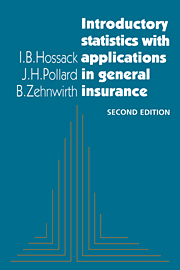Book contents
- Frontmatter
- Contents
- Preface to first edition
- Preface to second edition
- 1 Introduction and mathematical preliminaries
- 2 Elementary probability
- 3 Random variables and their distributions
- 4 Location and dispersion
- 5 Statistical distributions useful in general insurance work
- 6 Inferences from general insurance data
- 7 The risk premium
- 8 Experience rating
- 9 Simulation
- 10 Estimation of outstanding claim provisions
- 11 Elementary risk theory
- References
- Solutions to exercises
- Author index
- Subject index
9 - Simulation
Published online by Cambridge University Press: 05 June 2012
- Frontmatter
- Contents
- Preface to first edition
- Preface to second edition
- 1 Introduction and mathematical preliminaries
- 2 Elementary probability
- 3 Random variables and their distributions
- 4 Location and dispersion
- 5 Statistical distributions useful in general insurance work
- 6 Inferences from general insurance data
- 7 The risk premium
- 8 Experience rating
- 9 Simulation
- 10 Estimation of outstanding claim provisions
- 11 Elementary risk theory
- References
- Solutions to exercises
- Author index
- Subject index
Summary
Summary. Simulation can be a useful technique for solving quite difficult problems in general insurance. In this chapter we introduce some of the basic ideas and give a few elementary examples. We conclude with a more complicated NCD simulation example.
Random numbers and simulation
Problems often arise in statistical analysis which call for the use of random numbers. Survey samplers use such numbers to select random individuals from a population in order to estimate the parameters of the population. Experimental agriculturalists often find it necessary to assign different treatments (for example, fertilisers) to different blocks in a random manner in order to avoid biasing comparisons between treatments. Such an assignment relies on random numbers.
The theoretician may use random numbers to study the distribution of a complicated random variable which is defined in terms of other random variables with known distributions. Random observations on the variables with known distributions are generated using random numbers, and these random observations are then used to calculate random observations on the complicated random variable. From the simulated values, the theoretician can make inferences about the unknown distribution (shape, mean, variance, skewness, etc.). Various tables of random numbers have been published. For example:
Fisher, R.A. and Yates, F. (1963). Statistical Tables for Use in Biological, Agricultural and Medical Research (sixth edition). Oliver and Boyd.
Rand Corporation. (1955). A Million Random Digits and 100 000 Normal Deviates. The Free Press, Glencoe, Illinois.
Information
- Type
- Chapter
- Information
- Introductory Statistics with Applications in General Insurance , pp. 177 - 205Publisher: Cambridge University PressPrint publication year: 1999
